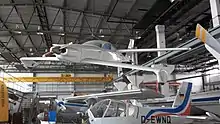Viking Dragonfly
The Viking Dragonfly is an American amateur-built aircraft, designed by Bob Walters [2] and produced by Viking Aircraft LLC of Elkhorn, Wisconsin. The aircraft is supplied as a kit or as plans for amateur construction.[3]
| Dragonfly | |
|---|---|
.jpg.webp) | |
| Dragonfly Mk II | |
| Role | Light aircraft |
| National origin | United States of America |
| Manufacturer | Viking Aircraft LLC |
| First flight | June 16, 1980[1] |
| Number built | 500+ (2003)[1] |
| Developed from | Rutan Quickie |
Design and development
The Dragonfly is a two-seater aircraft that features a tandem wing layout with a forward wing mounted low and the other behind the cockpit in a shoulder position, a two-seats-in-side-by-side configuration enclosed cockpit under a bubble canopy, fixed landing gear and a single engine in tractor configuration. The cockpit is 43 in (109 cm) wide[3]
The aircraft is constructed from composites, based on construction techniques pioneered by Burt Rutan at Rutan Aircraft Factory (RAF). The airframe design is visually similar to the RAF's Quickie 2, which was developed independently, but the Dragonfly has larger airfoils and a smaller engine, resulting in a slower but more docile handling aircraft. Its forward 20 ft (6.1 m) span wing employs a GU25-5(11)8 mod airfoil, when the aft wing (span 22 ft) uses an Eppler 1212 airfoil.[4] Both wings have a total area of 92.2 sq ft (8.57 m2). Standard engines used include the 60 hp (45 kW) Volkswagen air-cooled engine and the 85 hp (63 kW) Jabiru 2200 four-stroke powerplants. Construction time from the supplied kit is estimated as 700 hours, while from plans is estimated at over 1200 hours.[1][3]
Operational history
The Dragonfly was given the Outstanding New Design Award at the EAA Convention in 1980.[5] By 1998, 500 examples of all variants were reported as flying.[3]
Variants

.jpg.webp)
- Dragonfly Mk I
- Original version with main landing gear mounted in fairings at the lower wing tips. Operations require paved runways and wide taxiways due to widely spaced main wheels.[3]
- Dragonfly Mk II
- Version with conventional landing gear.[3]
- Dragonfly Mk III
- Version with tricycle landing gear.[3]
Specifications (Mark III Millenium)
Data from [1]
General characteristics
- Crew: 1
- Capacity: 1 passenger
- Length: 19 ft 0 in (5.79 m)
- Wingspan: 22 ft 0 in (6.71 m)
- Height: 5 ft 6 in (1.68 m)
- Wing area: 92.1 sq ft (8.56 m2)
- Empty weight: 600 lb (272 kg)
- Gross weight: 1,250 lb (567 kg)
- Powerplant: 1 × Jabiru 2200 air-cooled flat-four
Performance
- Cruise speed: 130 mph (210 km/h, 110 kn)
- Stall speed: 55 mph (89 km/h, 48 kn)
- Never exceed speed: 180 mph (290 km/h, 160 kn)
- Range: 500 mi (800 km, 430 nmi)
- g limits: +4.4, -2.0
- Rate of climb: 850 ft/min (4.3 m/s)
References
- Jackson 2003, pp. 734–735.
- Bill Cox : "...Bob Walters, an ex-Navy fighter pilot with a penchant for designing his own airplanes. Walters came up with his two-seat adaptation of the Quickie..." in Homebuilt Aircraft, March 1985, "New legs for a Dragonfly", page 18
- Purdy, Don: AeroCrafter - Homebuilt Aircraft Sourcebook, page 284-285. BAI Communications, 15 July 1998. ISBN 0-9636409-4-1
- Lednicer, David (2010). "The Incomplete Guide to Airfoil Usage". Retrieved 4 December 2012.
- "General Flight" Flight International, 1 November 1980 p1681
- Jackson, Paul. Jane's All The World's Aircraft 2003–2004. Coulsdon, UK: Jane's Information Group, 2003. ISBN 0-7106-2537-5.